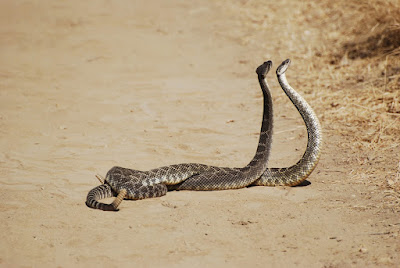It's that time of year again. About six states still hold rattlesnake roundup events each spring where thousands of rattlesnakes, mostly Eastern and Western Diamondbacks, are hunted and then brought into these weekend long festivals to be slaughtered. Proponents of these hunts argue that the culling of rattlesnakes is necessary each year to keep the population in check. They claim if they didn't do the hunts overpopulation would result in more snakebites on humans, pets and livestock. But there is no data anywhere that supports this and there hasn't been a report of any livestock being bitten in the last twenty years. With the Eastern Diamondback especially, populations are dwindling from loss of habitat so the added pressure of thousands of snakes being taken each year puts these reptiles at great risk. Sweetwater, Texas boasts the biggest roundup. Here is a link to the Sweetwater Jaycees' website calander on this year's event.
http://www.rattlesnakeroundup.net/roundup.html
Despite ongoing efforts to ban these barbaric hunts they are still going strong. Texas, Alabama, Kansas, Georgia, Oklahoma and New Mexico hold annual festivals promoting the slaughter of these iconic snakes. For several months prior to the event, hunters go out and capture as many snakes as possible. Many techniques used in these hunts are harmful to the environment. A popular method is pouring gasoline down the burrows to drive them out. Since many other animals use these same burrows they are adversely affected too. In the Southeast the critically threatened Gopher Tortoise digs burrows where Diamondback rattlers like to reside as well. Gassing, as it is called, is devastating to these tortoises.
The Center for Biological Diversity is one group that is fighting hard to ban the roundups.
Here is a link to information on their efforts to stop this gruesome tradition.
http://www.biologicaldiversity.org/campaigns/outlawing_rattlesnake_roundups/
Their work has had some successes. Due to pressure from them and other conservation groups some towns have transformed the roundup into a festival that celebrates nature and promotes conservation. The rattlesnake is still the big draw but they are alive and well and used to educate people on their important place in the ecosystem. Hurrah for Claxton, Georgia! They are one such town that now has a wonderful weekend long festival celebrating not only the rattlesnake but wildlife in general. Follow this link for that story.
http://savannahnow.com/news/2012-01-28/claxton-rattlesnake-roundup-gets-makeover#
Help spread the world on this destructive practice. These little towns claim these roundups bring in much needed revenue to hard hit economies but I'm willing to bet a more eco-friendly festival on the wonders of nature could put a lot of butts in the seats.
Let's turn this...

Into this...




















